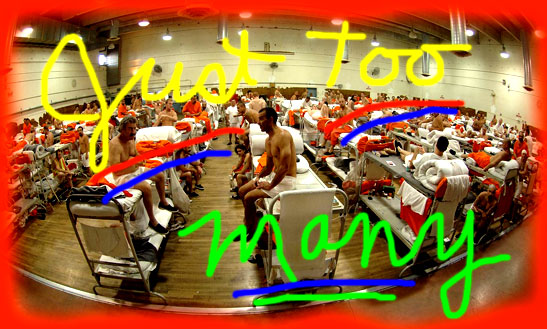
Monday a panel of three judges did what U.S. Judge Thelton Henderson has been threatening to do for several years now: they told California that the state has to reduce the number of people in its prisons by up to 57,000 inmates. Period. No arguments. No more excuses.
(The text of the ruling is here.* A well-reported LA Times story is here. The NY Times’ Tuesday story is here.)
And here’s the text of the fit Attorney General Jerry Brown has thrown in response to the ruling.
It didn’t have to come to this.
The governor and the state legislature should have found ways to lower the prison population long ago— through sentencing reform, parole policy reform, and by instituting “best practices” rehabilitation and reentry programs that would slow the state’s ghastly recidivism rate.
Yet, except for a few outliers like State Senator Gloria Romero, nobody in Sacramento has made the slightest effort to slow California’s inmate growth, which has now led to an overcrowding catastrophe and a slew of lawsuits.
It has also produced a health care system that is too broken to leave as is, and too expensive to fix properly, given our budget woes.
So Henderson and his fellow judges have stepped in.
Here’s what the SF Chron said about the move by Henderson and his federal colleagues:
In what it labeled a tentative ruling, the three-judge panel said prison populations must be reduced so inmates’ health care can be brought up to constitutional standards. Crowding at prisons can be eased by measures that will not flood the streets with dangerous inmates, such as changing parole policies and sending some low-risk inmates to county custody, the panel said.
“The evidence is compelling that there is no relief other than a prisoner release order that will remedy the unconstitutional prison conditions,” said the judges, who held a trial on prison overcrowding in San Francisco last fall.
California’s 33 prisons hold nearly 160,000 inmates, about twice their designed capacity. The judges said they were prepared to impose a limit of between 120 and 145 percent of capacity…..
In other words, if the ruling becomes final, the state will have to cut the population by between 36,000 to 57,000 inmates.
The minute the ruling came down, the governor said he would appeal when and if the order became official.
At the same time, AG Jerry Brown fulminated mightily against what he characterized as judicial meddling:
“This order, the latest intrusion by the federal judiciary into California’s prison system, is a blunt instrument that does not recognize the imperatives of public safety, nor the challenges of incarcerating criminals, many of whom are deeply disturbed.”
Yes, well. The above harrumphing sounds wonderfully righteous. Unfortunately, it’s not particularly true.
As the LA Times points out, the judges came up with plan that was very mindful of public safety:
If the state is ordered to reduce the prison population, it would likely be able to do so over two or three years, so it would not have to release large numbers of inmates at once. Some methods of cutting the population include limiting new admissions, changing policies so parole violators return to prison less frequently, and giving prisoners more time off of their sentences for good behavior and rehabilitation efforts.
Jerry Brown is a very, very smart man. Hence it is hard to understand why he trotted out a pile of tired old law-and-order fear mongering.
It will be interesting to see who wins this one.
Right now, I’m betting on Judge Henderson.
(*NOTE: Thanks to How Appealing for the text of the ruling.)
********************************************************************************************************
FEDERAL HELP FOR CALIFORNIA
As mentioned above, one of the obvious ways that California could reduce its inmate population, is to lock up fewer people. So how does one lock up fewer people without compromising public safety?
For some years now, experts have answered that question by pointing to ways that the state might reduce its 70 percent recidivism rate. Put another way, we need to give people the tools to transition more successfully out of prison and into their communities—so that they stop being repeated guests at the state’s overcrowded prisons at a cost of $47,102 a year.
But rehabilitation and reentry programs cost money, and the state is broke. So what to do?
As it happens, the federal government poised to help the states with some of the financial burden in the form of the Second Chance Act, a bill that authorizes $165 million in grants for reentry to state and local government and community organizations.
Last year, the second Chance Act was passed with broad bipartisan support and signed into law on April 9, 2008.
But it was never funded.
The House and Senate Appropriations Committees will soon begin work on their recommendations about what to fund for fiscal year 2010, which begins on October 1, 2009.
Giving one’s friendly Congress person or Senator a shove on the issue of Second Chance, even in this economic climate, might be a good thing.
Remind them that helping people retool and jumpstart their lives is far cheaper than warehousing those same people.
Nationally, corrections spending is behind only healthcare, education and transportation in consuming state dollars.
And when it comes to budget eating, California’s prisons are the worst.

We could cut prison population by putting “Ol’ Sparky” into full-time service. What remaining prisoners don’t fit into prisons should be transferred to courtroom galleries.
Obviously, California could use a better grade of prisoners.